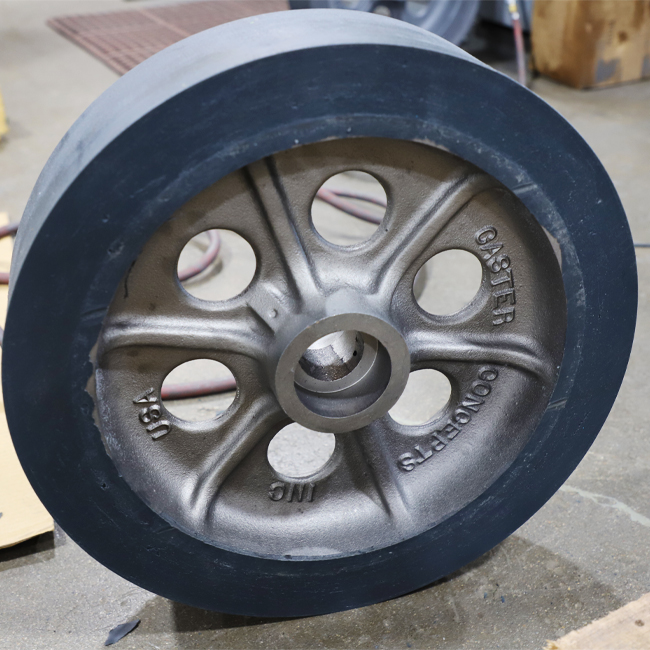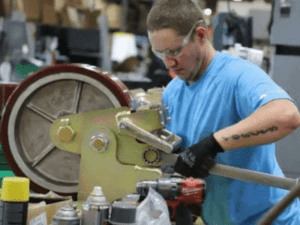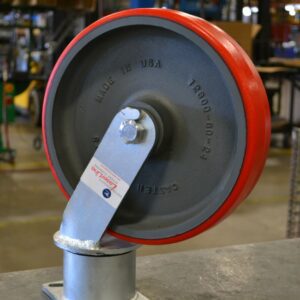

Industrial casters and wheels play a crucial role in the material handling and manufacturing sectors, enabling the efficient movement of heavy loads with minimal effort. However, specifying casters for applications that carry loads of 10,000 lbs or above, additional challenges must be considered to ensure optimal performance, safety, and longevity.
These challenges stem from various factors such as load capacity requirements, speed limitations, environmental conditions, and flooring quality. The importance of selecting the appropriate caster and wheel combination cannot be overstated, as it directly impacts operational efficiency and worker safety.
Key Takeaways
|
Accurately determining load capacity for industrial casters and wheels that transport heavy loads exceeding 10,000 lbs. presents a critical challenge, as it necessitates meticulous calculations and material selection to ensure optimal performance and safety.
When tackling this task, safety factors for load capacity must be considered, which involves accounting for the maximum potential weight placed on each caster or wheel.

How to Choose the Right Heavy Duty Caster
Additionally, calculating the push-pull force required to move these heavy loads aids in selecting ergonomic casters that minimize strain on workers while maintaining operational efficiency. Load capacity considerations for heavy loads are essential in identifying extra heavy duty casters with specifications tailored to support the intended load without compromising durability or stability.
Engineers must also consider how speed affects overall performance when specifying industrial casters and wheels for transporting loads of 10,000 lbs. or above. This includes evaluating factors such as rolling resistance, heat dissipation due to friction between the wheel’s surface and floor, and increased wear on components under high-speed operations.
RELATED: How fast can I tow my polyurethane wheels?
As such, the importance of speed in caster and wheel selection is crucial not only from an operational standpoint but also to ensure user safety by reducing the likelihood of accidents associated with excessive speeds or abrupt stops during transport. Considering these challenges and load capacity requirements, professionals can make informed decisions when specifying industrial casters and wheels capable of handling exceptional weights efficiently and safely.
Various caster wheel types are designed to handle different speeds and applications. For instance, swivel-on-swivel casters provide increased maneuverability for quickly navigating tight spaces or changing directions. Still, they may be unsuitable for moving heavy loads at high speeds due to reduced tracking unless swivel locks are used.
On the other hand, dual-wheel casters offer improved weight distribution and stability compared to single-wheel options. Still, they may require more force for initial movement due to the higher contact area with the floor surface. The table below illustrates some key characteristics of different caster wheel types:
| Caster Wheel Type | Speed Capabilities | Load Distribution | Maneuverability |
| Swivel Casters | Low-Medium | Moderate | High |
| Rigid Casters | Medium-High | Moderate | Low |
| Dual Wheel Casters | Medium-High | High | Moderate |
By evaluating these factors with other application-specific requirements like load capacity and environmental conditions, engineers can make informed decisions when selecting industrial casters and wheels that support the efficient and safe movement of loads weighing 10,000 lbs. or more.
In addition to speed considerations, it is also vital to account for various environmental factors that could impact the performance of these components in specific applications.
Environmental factors can significantly impact performance, durability, and safety when transporting heavy loads with a heavy duty industrial caster. These factors include temperature fluctuations, exposure to moisture or corrosive substances, and the presence of debris or other obstacles.
For example, high temperatures may cause certain materials to expand or lose tensile strength, while low temperatures could lead to brittleness and cracking. The presence of moisture can accelerate corrosion rates for metal components and compromise the structural integrity of non-metallic materials such as plastics and rubber. Exposure to chemicals or corrosive substances may also necessitate specific material choices resistant to degradation.
In addition to considering how these environmental factors will affect the durability of casters and wheels designed for carrying 10,000 lbs or more, it is essential to select appropriate designs that accommodate any potential constraints posed by the operating environment. For instance, if a caster assembly must navigate around obstacles or debris frequently encountered in industrial settings, selecting swivel casters with adequate clearance height may be necessary.
Flooring conditions significantly influence the performance of caster assemblies, particularly when transporting heavy loads, as they can affect factors such as rolling resistance, maneuverability, and wear on both the wheels and floor surfaces.
Uneven or damaged floors can increase the rolling resistance of casters, making it more difficult to push or pull heavy equipment. Moreover, small obstacles like debris or cracks in the flooring may interfere with smooth movement and cause premature wheel wear or even damage the floor itself.
The presence of moisture, chemicals, or other contaminants on floors can also impact caster performance by causing corrosion or affecting wheel traction.
 An appropriate selection of caster types and wheel materials is crucial to maintain optimal caster performance under various flooring conditions. Wheels made from materials such as polyurethane and nylon offer low rolling resistance and high weight-carrying capacity while resistant to most chemicals.
An appropriate selection of caster types and wheel materials is crucial to maintain optimal caster performance under various flooring conditions. Wheels made from materials such as polyurethane and nylon offer low rolling resistance and high weight-carrying capacity while resistant to most chemicals.
On the other hand, choosing casters with larger diameter wheels helps in reducing rolling resistance on uneven surfaces and ensures smoother movement over obstacles.
Last but not least, selecting casters that have shock-absorbing features will help minimize vibrations caused by irregularities in floor surfaces.
There are many factors to consider when choosing the right heavy duty industrial caster. However, taking the time to plan it out is crucial in ensuring optimal performance, longevity, and safety in material handling tasks by understanding the following:
Whichever caster suits your needs, durability is always a given with Caster Concepts. Our company is the leading supplier of industrial casters and wheels that can carry loads of 10,000 lbs. and much more. In addition, our casters are designed to perform under demanding conditions and continuous use. We also offer customization options so that you can choose features such as brakes or swivel locks to meet all your material handling needs.